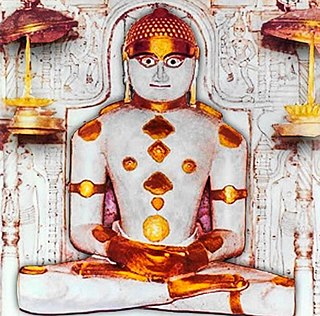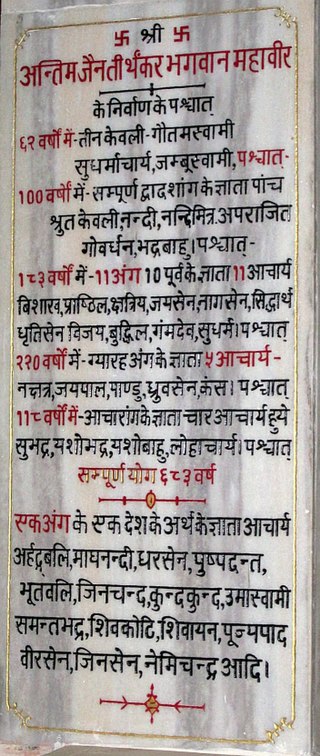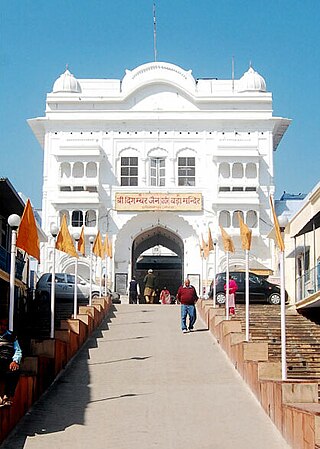This article lists, in chronological order, the names, signs, colors etc. of the 24 Tirthankaras in Jainism. [1] [2] [3] [4]
| S.No. | Tirthankara | Image | Heaven before birth | Birthplace; Consecration | Parents | Complexion | Symbol | Height | Number of Years Lived | Tree | Attendant spirits | Male disciple; Female disciple | Place of Nirvana | Birth |
|---|---|---|---|---|---|---|---|---|---|---|---|---|---|---|
| 1 | Rishabhanatha |  | Sarvarthasiddha | Ayodhya; Kailash | Nabhi by Marudevi | Golden | Bull | 1,500 meters | 592.704 quintillion years | Vata (Ficus benghalensis) | Gomukha and Chakreshvari | Pundarika; Brahmi | Ashtaapad | 10224 years ago |
| 2 | Ajitanatha |  | Vijayavimana | Ayodhya; Shikharji | Jitashatru by Vijaya | Golden | Elephant | 1,350 meters | 508.032 quintillion years | Shala (Shorea robusta) | Mahayaksha and Ajitabala; or Rohini | Simhasena; Phalgu | Shikharji | 5 x 10223 years ago |
| 3 | Sambhavanatha |  | Uvarimagraiveka | Shravasti; Shikharji | Jitari by Sena | Golden | Horse | 1,200 meters | 423.36 quintillion years | Prayala (Buchanania cochinchinensis) | Trimukha and Duritari; or Prajnapti | Charu; Shyama | Shikharji | 2 x 10223 years ago |
| 4 | Abhinandananatha |  | Jayantavimana | Ayodhya; Shikharji | Samvara by Siddhartha | Golden | Monkey | 1,050 meters | 352.8 quintillion years | Priyangu ( Setaria italica , sometimes known as Panicum italicum) | Nayaka and Kalika; or Yaksheshvara and Vajrashrinkhala | Vajranabha; Ajita | Shikharji | 10223 years ago |
| 5 | Sumatinatha |  | Jayantavimana | Ayodhya; Shikharji | Megharatha by Mangala | Golden | Goose | 900 meters | 282.24 quintillion years | Shala (Shorea robusta) | Tumburu and Mahakali; or Purushadatta | Charama; Kashyapi | Shikharji | 10222 years ago |
| 6 | Padmaprabhu |  | Uvarimagraiveka | Kaushambi; Shikharji | Shridhara by Susima | Red | Lotus | 750 meters | 211.68 quintillion years | Chhatra | Kusuma and Shyama; or Manovega or Manogupti | Pradyotana; Rati | Shikharji | 10221 years ago |
| 7 | Suparshvanath |  | Madhyamagraiveka | Varanasi; Shikharji | Supratishtha by Prithvi | Golden | Swastika | 600 meters | 141.12 quintillion years | Shirisha (Albizia lebbeck) | Matanga and Shanta; or Varanandi and Kali | Vidarbha; Soma | Shikharji | 10220 years ago |
| 8 | Chandraprabhu |  | Vijayantadevaloka | Chandrawati or Chandrapura; Sammed Shikharji | Mahasena by Lakshmana | White | Crescent Moon | 450 meters | 70.56 quintillion years | Naga | Vijaya and Bhrikuti; or Shyama or Vijaya and Jvalamalini | Dinna; Sumana | Shikharji | 10219 years ago |
| 9 | Suvidhinath |  | Anatadevaloka | Kakandi; Shikharji | Sugriva by Rama | White | Crocodile | 300 meters | 14.112 quintillion years | Shala (Shorea robusta) | Ajita and Sutaraka; or Mahakali | Varahaka; Varuni | Shikharji | 10218 years ago |
| 10 | Shitalnath |  | Achyutadevaloka | Bhaddilapura; Shikharji | Dridharatha by Nanda | Golden | Kalpavriksha | 270 meters | 7.056 quintillion years | Priyangu ( Setaria italica , a.k.a.Panicum italicum) | Brahma and Ashoka; or Manavi | Nanda; Suyasha | Shikharji | 10217 years ago |
| 11 | Shreyansnath |  | Achyutadevaloka | Simhapuri; Shikharji | Vishnuraja by Vishnu | Golden | Rhinoceros | 240 meters | 8.4 million years | Tanduka | Yaksheta and Manavi; or Ishvara and Gauri | Kashyapa; Dharani | Shikharji | 10212 years ago |
| 12 | Vasupujya Swami |  | Pranatadevaloka | Champapuri; Champapuri | Vasupujya by Jaya | Red | Buffalo | 210 meters | 7.2 million years | Patala (Bignonia suaveolens) | Kumara and Chandra; or Gandhari | Subhuma; Dharani | Champapuri | 4 x 10211 years ago |
| 13 | Vimalnath |  | Mahasaradevaloka | Kampilyapura; Shikharji | Kritavarma by Shyama | Golden | Boar | 180 meters | 6 million years | Jambu (Eugenia jambolana) | Shanmukha and Vidita; or Vairoti) | Mandara; Dhara | Shikharji | 1.6 x 10211 years ago |
| 14 | Anantnath |  | Pranatadevaloka | Ayodhya; Shikharji | Simhasena by Suyasha | Golden | Porcupine | 150 meters | 3 million years | Ashoka (Saraca asoca) | Patala and Ankusha; or Anantamati | Yasha; Padma | Shikharji | 7 x 10210 years ago |
| 15 | Dharmanath |  | Vijayavimana | Ratnapuri; Shikharji | Bhanu by Suvrata | Golden | Vajra | 135 meters | 1 million years | Dadhiparna (Clitoria ternatea) | Kinnara and Kandarpa; or Manasi | Arishta; Arthashiva | Sammed Shikharji | 3 x 10210 years ago |
| 16 | Shantinath |  | Sarvarthasiddha | Gajapura or Hastinapuri; Shikharji | Vishvasena by Achira | Golden | Deer | 120 meters | 100,000 years | Nandi (Cedrela toona) | Garuda and Nirvani; or Kimpurusha and Mahamanasi | Chakrayuddha; Shuchi | Shikharji | 10194 years ago |
| 17 | Kunthunath |  | Sarvarthasiddha | Gajapura or Hastinapuri; Shikharji | Suraraja by Shridevi | Golden | Goat | 105 meters | 95,000 years | Vata (Ficus benghalensis) | Gandharva and Bala; or Vijaya | Samba; Damini | Sammed Shikharji | 10194 years ago |
| 18 | Aranath |  | Sarvarthasiddha | Gajapura or Hastinapuri; Shikharji | Sudarshana by Devi | Golden | Fish | 90 meters | 84,000 years | Amba (Mangifera indica) | Yaksheta and Dhana; or Kendra and Ajita | Kumbha; Rakshita | Shikharji | 16,585,000 BCE |
| 19 | Mallinath |  | Jayantadevaloka | Mithila; Shikharji | Kumbharaja by Prabhavati | Blue | Kalasha | 75 meters | 55,000 years | Ashoka (Saraca asoca) | Kubera and Dharanapriya; or Aparajita | Abhikshaka; Bandhumati | Shikharji | 6,584,980 BCE |
| 20 | Munisuvrat |  | Aparajitadevaloka | Rajagriha; Shikharji | Sumitraraja by Padmavati | Black | Tortoise | 60 meters | 30,000 years | Champaka (Magnolia champaca) | Varuna and Naradatta; or Bahurupini | Malli; Pushpavati | Shikharji | 1,184,980 BCE |
| 21 | Naminatha |  | Pranatadevaloka | Mithila; Sammed Shikharji | Vijayaraja by Vapra | Golden | Blue Water Lily | 45 meters | 10,000 years | Bakula (Mimusops elengi) | Bhrikuti and Gandhari; or Chamundi | Shubha; Anila | Shikharji | 584,979 BCE |
| 22 | Neminath |  | Aparajitadevaloka | Sauripura; Girnar | Samudravijaya by Shivadevi | Black | Shankha | 30 meters | 1,000 years | Vetasa | Gomedha and Ambika; or Sarvahna and Kushmandini | Varadatta; Yakshadinna | Girnar | 84,000 years ago |
| 23 | Parshvanath |  | Pranatadevaloka | Varanasi; Sammed Shikharji | Ashvasena by Vamadevi | Green | Snake | 13.5 feet | 100 years | Dhataki (Woodfordia fruticosa) | Parshvayaksha or Dharanendra and Padmavati | Aryadinna; Pushpachuda | Shikharji | 872 BCE |
| 24 | Mahaveer Swami |  | Pranatadevaloka | Kshatriyakund; Pavapuri | Siddhartharaja and Trishala | Golden | Lion | 6 feet | 72 years | Teak (Tectona grandis) | Matanga and Siddhayika | Indrabhuti; Chandanabala | Pavapuri | 599 BCE |
The total length of the lifespans of all 24 Tīrthaṅkaras combined equals 2.603672 sextillion years.
















